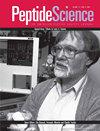Chitin-binding peptides from Capsicum annuum with antifungal activity and low toxicity to mammalian cells and Galleria mellonella larvae
IF 1.5
4区 生物学
Q4 BIOCHEMISTRY & MOLECULAR BIOLOGY
引用次数: 0
Abstract
In recent years, there have been several reports of the presence of toxic proteins in cultivated or wild plant species, which are implicated in plant defense mechanisms. The existence of these proteins raises the possibility of biotechnological applications originating from the development of new techniques to combat diseases caused by fungi. In this context, there are chitin-binding proteins. Chitin is an essential component of the fungal cell wall, so chitin-binding proteins are important in controlling fungal growth. Thus, the objective of this study was to characterize and evaluate the in vitro antimicrobial effect of peptides with chitin binding properties isolated from Capsicum annuum seeds on the growth of the genus Candida. Initially, proteins were extracted in phosphate pH 5.4, and a chitin column was equilibrated with sodium acetate (0.08 M, pH 4.5), where 50 mg of the peptide-rich heated fraction from each species was applied. Subsequently, the retained material was eluted with 0.1 M HCl. Tricine SDS–PAGE was used to visualize the peptides. After chromatography, two fractions, F1 (not retained in the chitin column) and F2 (retained in the chitin column, named Ca-F2), were obtained. Electrophoresis showed major protein bands between 3 and 14 kDa. Electrophoresis from chitin affinity chromatography also showed major bands between 3 and 14 kDa, especially for Ca-F2 retained in the column. One peptide obtained from the F2 fraction was identified by mass spectrometry and showed similarity to seed 2S albumin, named Ca-Alb2S. Ca-F2 inhibited the growth of C. albicans and C. tropicalis, was not toxic to mammalian cells and still had a high survival rate when tested in vivo on Galleria mellonella larvae. This is the first report of chitin-binding peptides isolated from Capsicum seeds through an affinity column and their biological activities. These studies are at an early stage; therefore, other tests are needed to study the mechanism of action of the fraction, since the findings indicate great potential for the development of new antifungal molecules.

来自辣椒的几丁质结合肽,具有抗真菌活性,对哺乳动物细胞和幼虫毒性低
近年来,有多份报告指出,在栽培或野生植物物种中存在与植物防御机制有关的有毒蛋白质。这些蛋白质的存在为生物技术的应用提供了可能性,而生物技术的应用则源于抗击真菌引起的疾病的新技术的开发。在这方面,有几丁质结合蛋白。几丁质是真菌细胞壁的重要组成部分,因此几丁质结合蛋白对控制真菌生长非常重要。因此,本研究的目的是鉴定和评估从辣椒种子中分离出来的具有几丁质结合特性的肽对念珠菌属生长的体外抗菌效果。首先,在 pH 值为 5.4 的磷酸盐中提取蛋白质,然后用醋酸钠(0.08 M,pH 值为 4.5)平衡甲壳素柱,再从每个物种中提取 50 毫克富含肽的加热部分。随后,用 0.1 M HCl 洗脱保留物质。使用三色 SDS-PAGE 对多肽进行显色。经过层析,得到了 F1(未保留在甲壳素柱中)和 F2(保留在甲壳素柱中,命名为 Ca-F2)两个馏分。电泳显示主要蛋白质条带在 3 至 14 kDa 之间。甲壳素亲和层析的电泳结果也显示出 3 至 14 kDa 之间的主要条带,尤其是保留在甲壳素柱中的 Ca-F2。通过质谱鉴定,从 F2 部分获得的一个肽与种子 2S 白蛋白相似,命名为 Ca-Alb2S。Ca-F2 可抑制白僵菌和热带僵菌的生长,对哺乳动物细胞无毒性,在对 Galleria mellonella 幼虫进行体内试验时仍有很高的存活率。这是首次报道通过亲和柱从辣椒种子中分离出的几丁质结合肽及其生物活性。这些研究还处于早期阶段,因此还需要进行其他试验来研究该肽的作用机制,因为研究结果表明,开发新的抗真菌分子具有很大的潜力。
本文章由计算机程序翻译,如有差异,请以英文原文为准。
求助全文
约1分钟内获得全文
求助全文
来源期刊

Peptide Science
Biochemistry, Genetics and Molecular Biology-Biophysics
CiteScore
5.20
自引率
4.20%
发文量
36
期刊介绍:
The aim of Peptide Science is to publish significant original research papers and up-to-date reviews covering the entire field of peptide research. Peptide Science provides a forum for papers exploring all aspects of peptide synthesis, materials, structure and bioactivity, including the use of peptides in exploring protein functions and protein-protein interactions. By incorporating both experimental and theoretical studies across the whole spectrum of peptide science, the journal serves the interdisciplinary biochemical, biomaterials, biophysical and biomedical research communities.
Peptide Science is the official journal of the American Peptide Society.
 求助内容:
求助内容: 应助结果提醒方式:
应助结果提醒方式:


